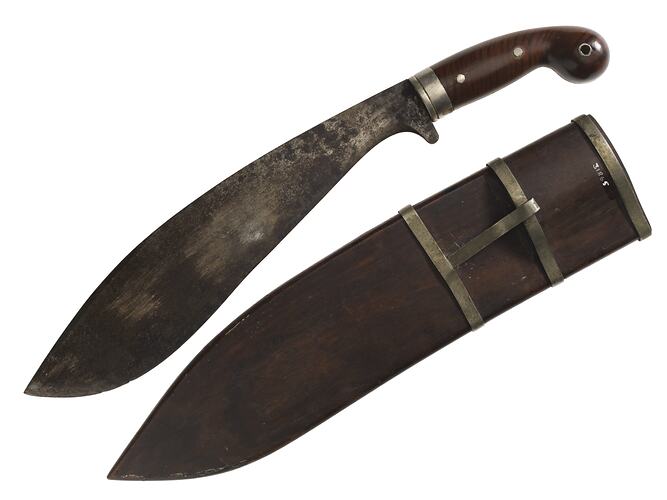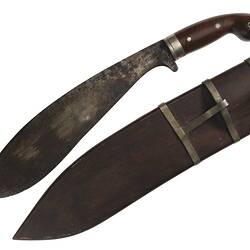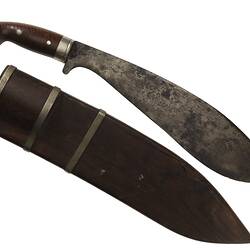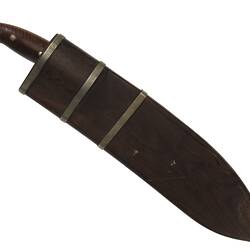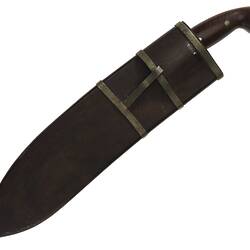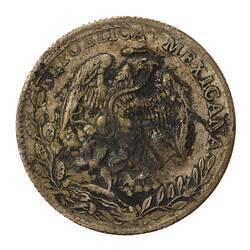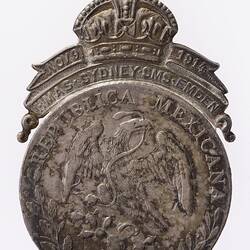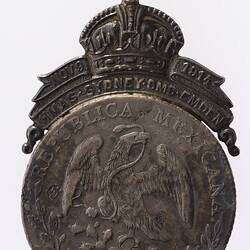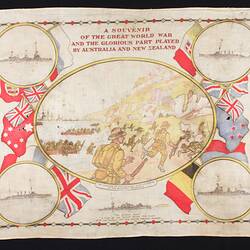Summary
Parang with white bands on sheath. Made by natives of Cocos Island - precise date unknown. Decorated with metal salvaged from the German cruiser SMS Emden, sunk by HMAS Sydney off Cocos Island on 9 November 1914, during World War I. A parang is a curved-bladed knife similar to a machete, used for cutting vegetation.
The SMS Emden was launched in Danzig in 1908, and was named after the city which sponsored its construction. Captain von Müller commanded the Emden during World War I, when it raided Allied shipping in the Indian Ocean. In November 1914 he planned to destroy the Eastern Telegraph Company wireless station at Direction Island, crippling allied communication in the Indian Ocean. However, the Emden was attacked by the more powerful HMAS Sydney in what became known as the Battle of Cocos, and von Müller desparately ran the ship aground to avoid sinking. The crew of the Emden suffered 131 dead and 65 wounded, and von Müller and remaining crew became prisoners of war. In later years, all officers serving on the Emden were awarded the Iron Cross First Class and 50 crewmen were given the Iron Cross Second Class; and the German government allowed all of the surviving crew to add the word 'Emden' to their names. The remains of the Emden were scattered over time: a 4.1 inch gun was installed in Sydney's Hyde Park (depicted in MM 014026); another is on display in the Australian War Memorial; while ship's whistle was given to General Sir John Monash.
Museum Victoria also holds two coins recovered from the Emden after battle with H.M.A.S. Sydney (NU 33539 and NU 33540), as well as two medals issued to commemorate the sinking of the Emden (NU 20937 and NU 20938).
Physical Description
Three white metal bands on the sheath.
More Information
-
Collecting Areas
-
Acquisition Information
Donation from Mrs Ford, 28 Jun 1985
-
Other Association (See Comments)
9 Nov 1914
Date of sinking of SMS Emden. -
Place Collected
-
Other Association (See Comments)
Germany
The SMS Emden was a German cruiser, launched in Danzig in 1908. -
Other Association (See Comments)
SMS Emden (Light Cruiser), Imperial German Navy
Relic from the shipwreck of the Emden, sunk by HMAS Sydney off Cocos Island on 9 November 1914, during World War I. -
Classification
-
Category
-
Discipline
-
Type of item
-
Overall Dimensions
508 mm (Length), 50 mm (Width), 100 mm (Height)
-
References
Information on the SMS Emden from Wikipedia, SMS Emden (1908), [Link 1](1908), accessed 8/3/2012.
-
Keywords
Knives, Knives: Cocos Islands, Naval Vessels, Parangs, World War I, 1914-1918, War Trophies
